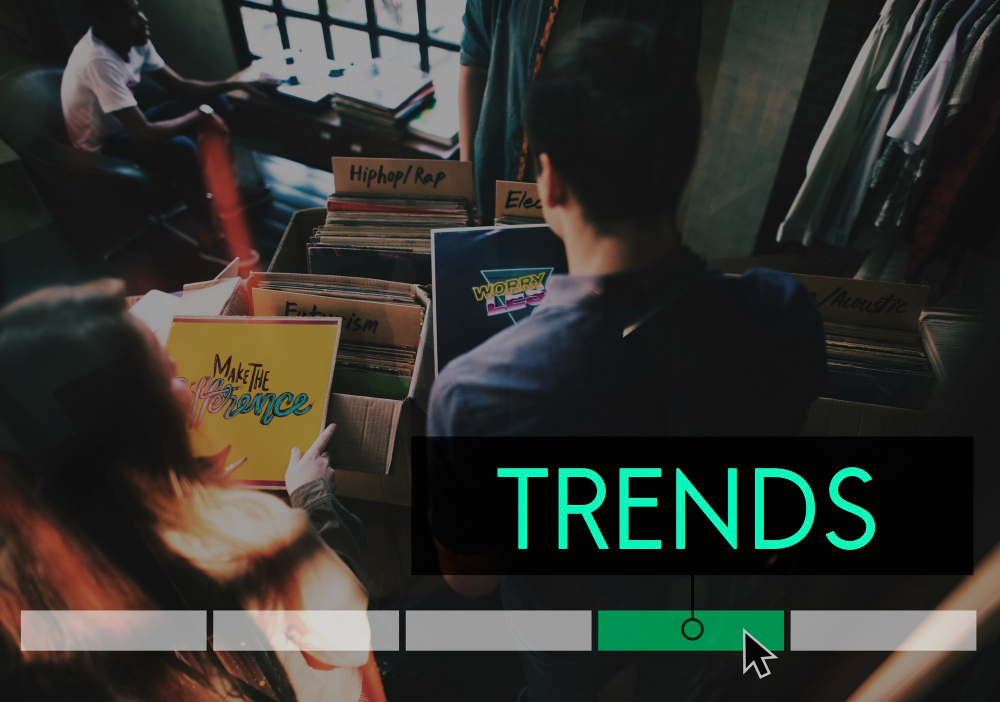Ecommerce Trends to Follow
Multi-platform presence, integration of artificial intelligence into online sales, and the necessity to be everywhere at once are essential for modern businesses. Trends that help increase the growth dynamics of websites and demand for specific goods and products are the tools that must be utilized in all projects. Moreover, online commerce has impressive growth potential, and its volumes will only increase in the coming years. With this in mind, it is essential to consider what changes will need to be implemented shortly to promote websites and turn these technologies into actual financial turnover and profit maximization.
The biggest part of our digital transformation is changing the way we think.
Simeon Preston
Understanding Ecommerce in 2025
Today, ecommerce trends encompass various relevant, powerful, innovative tools, tactics, practices, and technologies utilized to promote, expand, and optimize businesses. Through them, not only does marketing automation occur, but they also help increase recognition, online visibility, and popularity, positively impacting sales for a specific brand’s ecommerce store being promoted online.

The ecommerce industry is actively evolving, and everything around it is subject to digitalization. This is a normal phenomenon, so by using online and content marketing, it is possible to ensure the desired growth and promotion of ecommerce businesses globally through managing accounts on social media, publishing in well-known and prestigious blogs, and maintaining corporate news resources.
Top Ecommerce Trends of 2025: A Breakdown
Analyzing the latest ecommerce tendencies of 2024, it can be understood that the digitization of procurement processes is happening rapidly and continuously. To avoid getting lost, it is necessary to understand each tool that all business owners should use thoroughly.

Key 15 Ecommerce Trends Shaping the Future
Adaptability is about the powerful difference between adapting to cope and adapting to win.
Max McKeown
The future of ecommerce depends solely on the development of Internet technologies, which are constantly being improved and modernized. Online transactions between sellers and buyers from different parts of the world, full-fledged internet-based shopping, and high-quality customer service are accurate, achievable, practical tools people use worldwide. It allows sellers to quickly expand the boundaries of their target audience, bypassing barriers. It enables buyers to find necessary goods, products, and more in compressed timeframes and purchase them through a simplified purchasing process. Plus, the possibility of benefiting from fast, free delivery offered by online stores and stores created on social media platforms is always possible.

AI-Powered Personalization
One of the ecommerce tendencies is using buzzworthy artificial intelligence. It can be employed in various aspects of modern digital commerce to enhance customer and client experiences, fully optimize all crucial processes, and increase sales and profits. Artificial intelligence algorithms help tailor the functioning of ecommerce businesses’ websites to current trends in online robot work.
The Rise of Hybrid Commerce
Hybrid commerce involves regular offline employees’ partial or complete transition to remote work online. It is known that online shopping is breaking records, so purchases in offline stores and retail outlets are lagging. The ecommerce industry is evolving along with the World Wide Web, so modern employers have started combining remote and office work. Many major brands operate in a hybrid commerce format, breaking records in popularity.
Augmented & Virtual Reality Shopping Experiences
The augmented reality era in online customer service is gradually taking the lead. In the age of voice search, machine learning, marketing automation, mobile devices, and new interfaces, customers want to interact with brands without intermediaries. This is where one of the ecommerce trends comes in — virtual and augmented reality. The technology helps replace real shopping with an online retailer. This marks the beginning of the era of digital self-service, which entails benefits such as time savings, comfort, and convenience.
Strengthening Customer Relationships
High-quality customer support is one of the tasks that e-commerce’s current tools and technologies can address. Every store on social media or ecommerce needs to ensure that customers feel like unique clients. People appreciate the pleasant treatment and look for ways to improve their shopping experience, which modern ecommerce businesses can facilitate through digital commerce trends.
Prioritizing Customer Support
The future of ecommerce depends on quality customer service that leaves a positive impression on people. Modern businesses need to understand the customer’s emotions and satisfy their growing needs (this can be achieved by using current technologies and tactics in online sales trends on the website). A pleasant service experience will strengthen loyalty and lead to repeat purchases.

Social Commerce Boom
The growth of social commerce contributes to social interaction and communication among online users who buy and sell goods, products, and services. Marketers and specialists have learned to utilize this channel to attract more sales from social platforms. The creation of social commerce is focused on finding solutions that meet consumer needs.
Subscription Models Gaining Traction
Every month, people willingly and increasingly subscribe to brands’ websites. The subscription model, as a relevant tool, is gaining momentum. The technology involves selling a product or service for a periodic fee. Subscriptions have become a relevant online sales trend and a strategic approach to revenue management and growth for various ecommerce businesses.
Headless Commerce for Flexibility
Unified and headless commerce in the ecommerce industry is a relatively young technology where the technological part and the external interface are disconnected and then connected through a series of electronic commerce trends. Supporting headless commerce for B2B and B2C, this approach enables businesses to tailor experiences to different customer needs while maintaining maximum flexibility. This is one of many technologies that promise complete freedom to create incredible online purchasing experiences and provide quality shopping experiences for all customers. Businesses can sell anywhere without restrictions on content, design, etc.
Diverse Payment Options
Businesses that provide diverse modern payment options for services (whether purchasing an e-book, a machine learning course, or various products) will significantly improve the customer experience. One of the key elements of economic relationships between business owners and customers is payment. Cashless payment and other electronic payment options are currently the most progressive way of financial interaction with people when making online purchases.
Voice & Visual Search Integration
Integrating current ecommerce channels such as visual and voice search is another promising direction for ensuring marketing automation. Such tools have a positive impact on the online shopping experience. Furthermore, the technology allows for robust, fast, and comfortable customer support and establishes more vital communication. Virtual voice and visual assistants are the future that is already in operation today.

Optimizing Conversions for Success
A new payment option or payment model aims to attract the necessary volume of conversions. The strategy to increase the conversion rate allows targeted user actions to be purchased at a fixed price. This includes calls, orders, subscriptions, form submissions, and sales. Through these actions, conversion rates grow much faster, and such a model is available for optimizing websites of various types of businesses — from small to large, from startups to experienced advertisers.
Streamlining Marketing with Automation
Marketing automation helps brands regularly attract more leads, reduce advertising expenses, improve communication with target buyers, and optimize routine tasks. When a technology like an online fulfillment center is used, specialists and marketers can be relieved of functions such as organizing email campaigns or publishing new content on websites. Marketing automation is the future, as the technology can be implemented in any business project.
Importance of Fast & Free Delivery
The future of ecommerce depends not only on innovative tools but also on services offered to customers engaging in online shopping. Providing fast and free delivery is not only a customer support service but also a service that makes shopping economical for consumers. Everyone loves to save money, so free worldwide delivery of goods and products is a global, powerful alternative solution for increasing sales.
Leveraging Zero-Party Data
The zero-trust model of big data is an approach to data privacy. It is based on ensuring full data privacy and can create new opportunities for compromising or stealing user and administrator credentials or other website information. The big data model allows specialists to regulate access to web resources, systems, platforms, and data without relinquishing control. Data protection always comes first.
Sustainable Practices in Online Shopping
Another modern ecommerce tendency is the concept of sustainable development. This is another form of customer support based on implementing changes from nano (shaping the appropriate mindset among managers) to macro (changes at the level of laws, states, and social institutions). Sustainability marketing aims to meet demand in a way that enhances public welfare and conserves natural resources for future generations.
The Future of Ecommerce
E-commerce has become an essential aspect of the business world. With the growth of online purchases with convenient payment options, businesses must have a robust global presence in cyberspace to remain competitive. Therefore, new innovative solutions come into play by implementing relevant and competent trends for online shopping. The future of ecommerce depends on advanced technologies; as we can already see today, they are changing the customer experience. Therefore, marketers and specialists increasingly use machine learning, social commerce personalization, AR/VR, subscriptions, visual voice search, ethical and sustainable procurement methods, and retailing.

How Ecommerce is Evolving in 2024
The prospects for electronic commerce trends 2024 are promising and will surpass all expectations. As before, shopping on the Internet will remain relevant, but now, there is the possibility of using instant payment systems. Mobile shopping will become more in demand because all modern users utilize portable and compact mobile devices. The main challenge for business owners will be ensuring the cybersecurity of their websites at a high level, effective verification, implementing generative artificial intelligence, hyper-personalization, solutions for the abandoned cart issue, ecological sustainability, and sustainable development.
Ecommerce vs. Physical Stores
It’s time for all business owners to understand that the future of ecommerce lies in online sales. Therefore, offline stores, retail points, and office spaces can only be opened where the business is locally registered. Accordingly, one should only consider implementing local SEO. Developing websites on the Internet and promoting them with the consideration of machine learning specialists who will manage the business project is primarily the solution that will be very profitable financially. Considering the actualization of hybrid commerce, all modern small, medium, and large businesses should consider this today.
Ecommerce Sales Growth Statistics
The growth of ecommerce sales has not stopped and will not stop. Today, there are not only single fulfillment centers but multiple different automated systems and online programs that can control sales online. As statistics show, by the end of 2024, global online sales are expected to reach staggering trillions of US dollars. As an increasing number of people worldwide opt for online shopping, a quarter of all retail sales will be accounted for by e-commerce shortly. Such trends for online shopping are both forecasted and expected.

How do Ecommerce Trends will affect your business?
Machine learning has become very popular because one of the progressive ecommerce trends is integrating artificial intelligence into various online business projects. But besides this, among other trends capable of successfully and effectively impacting business, we can highlight:
- chatbots, interactive marketing;
- recommerce, or the market for “pre-owned” goods;
- “green” logistics and circular economy;
- progressive web applications (PWA) for mobile gadgets;
- “5G” mobile communication standard;
- sales through popular social platforms;
- virtual “smart” commerce;
- offline retailing;
- transition to “headless” e-commerce;
- backend-functional web resource themes, and more.
All these progressive trends open up new promising opportunities for online stores. Marketers and promotion specialists should focus on machine learning and study as much new information in this direction as possible to lead businesses to online leadership in local and global markets.

Industry-Specific Trends
Internet technologies can directly influence online shoppers’ changing needs and behaviors. Therefore, it is essential for online stores to carefully adapt to these critical needs, new tools, and innovative tactics that will help demonstrate and support competitive advantages and user satisfaction. For this reason, businesses must stay abreast of all the latest e-commerce directions and implement them in their projects as quickly as possible. This will allow them to be customer-centric and stay ahead of their competitors.
- Fashion
In the fashion industry, the most relevant and modernized ecommerce trends include sustainability (including environmental and social responsibility), digital transformation (e-commerce, use of data and technologies), brand management, and marketing in the face of rapidly changing tendencies and needs of modern consumers. It is also important to implement tools for globalization, intelligent technologies, wearable electronics, circular economy, and inclusivity.
- Automotive
Key ecommerce trends in the automotive industry include the development of information technologies in this sector. For example, IoT is a concept that involves integrating various devices and systems into a single network with remote control and management capabilities. Artificial intelligence in cars, autonomous driving technology, autonomy (green industry and battery technology), and other marketing innovations are also worth mentioning.
- Food
Among the significant e-commerce movements in the food industry, technologies for cooking dishes with healthy ingredients, maximum transparency of supply chains, and humane treatment of animals play a crucial role. Among the latest marketing solutions, it is worth emphasizing custom food printing using 3D printing, using natural ingredients for dishes, managing with online services in mind, creating edible barcodes, zero waste living, etc.
- Grocery
Some of the splendid and latest ecommerce tendencies in the grocery sector include online marketing for natural products provided by nature. The food technology market involves solutions that allow businesses to stay afloat, including waste reduction, restaurant subscriptions, fast service technologies, mobile apps for ordering delivery, robotization, back-office automation, and much more.
- Beauty
Modern and progressive ecommerce trends in the beauty and health industry include interactivity (communication online with the audience 24/7), targeting (allows selecting a target group and showing them advertisements), web analytics (helps understand which actions are most effective, what attracted visitors to the website, and then led to purchases and service orders). It is also worth mentioning chatbots and other web programs that save people time when they have questions.
- Retail
The most crucial ecommerce directions and marketing technologies needed to promote a retail business include improving product placement on shelves, reducing queues at cash registers, the ability to self-pay for purchases using digital handheld equipment (portable cash register handheld devices), implementing concepts (IoT), etc. Remembering that retail is increasingly moving towards an online format is important.

B2B and B2C Eommerce Trends
Current trends in commercial trading for B2B or business-to-business are characterized by artificial intelligence, personal brand development, a focus on relationships (global transition to the online space), and personalization (establishing long-term partnerships). Implementing a mobile strategy, content marketing, influencer marketing, SEO, and SEM are also relevant.
For B2C or “business-to-consumer,” changes that have become even more promising with the development of internet technologies include the use of short-form video content, design of websites optimized for mobile and portable devices, creation of interesting and valuable written content (with social responsibility), influencer marketing, SEO, SEM, and a focus on social online sales.
DTC and D2C Ecommerce Trends
New ecommerce trends for DTC involve incorporating valuable product content, LTV (Lifetime Value), exploring new relevant channels for advertising (to generate demand), and enhancing personalization and international tools (to successfully expand globally).
New ecommerce must-have instruments for D2C include multitasking, tools for improving online customer interactions, a new approach to advertising and marketing, presenting brand value through content marketing, improving the visual design of websites, and more.
Embracing Ecommerce Trends for Success
Modern brands and businesses must embrace the ongoing digital transformation as ecommerce evolves. Rapid growth rates enable websites undergoing optimization and promotion efforts to stay ahead of competitors, be customer-centric, and stand out from all rivals. New trends in 2024 will allow consumers to interact with brands and businesses to fully adapt to new online robot algorithms.

Follow Industry Leaders & Publications
By tracking the publications and activities of foremost market leaders, one can consistently stay on trend and make timely adjustments to the business plan. This will help set new goals and understand what innovative tools, tactics, practices, and technologies need to be implemented to attract more target customers and make the website as popular as possible on the internet.
Embracing Ecommerce Trends for Success
Modern brands and businesses must embrace digital transformation because ecommerce continues evolving. Rapid growth rates enable web resources undergoing optimization and promotion efforts to stay ahead of competitors, be customer-centric, and stand out from all rivals. New trends in 2024 will allow consumers to interact with brands and businesses to adapt to new algorithms of online robots fully.
Follow Industry Leaders & Publications
By tracking the publications and activities of prominent industry leaders, one can stay constantly in tune with the latest trends and make relevant adjustments to their business plan. This approach helps set new goals and understand what innovative tools, tactics, practices, and technologies need to be implemented to attract more target customers and make the website as popular as possible on the internet.
Stay Updated with Research & Reports
For specialists and marketers involved in promoting e-commerce business projects, it is essential to consider the latest trends, stay informed about research conducted in modern global, local, and international markets, and be aware of reports from major corporations, firms, and global leaders. This approach aids in achieving the pinnacle of success when promoting a specific brand online.
Analyze Customer Behavior
Conducting customer behavior analysis is one of the few essential marketing tools that involves collecting, studying, and interpreting information specifically about the actions and preferences of target customers. This tool allows for a deeper understanding of preferences, valuable insights, and learning about people’s intentions. This, in turn, contributes to improving strategy and enhancing the effectiveness of interactions with people.
Gather Customer Feedback
Collecting positive feedback from real customers and clients can increase trust, boost demand for products or services, strengthen a company’s reputation in the modern market, and significantly enhance its authority. Reviews are one marketing tool that needs to be showcased to all Internet users to influence their decision to purchase goods or services.
Benchmark Your Strategy Against Competitors
A business plan or individual strategy should include a comprehensive summary, company overview, market analysis, products and services, marketing and financial plans, and logistics and operations plans. These points must be compared with competitors who implement current marketing tools and technologies to promote their business projects. Through comparative analysis of strategies, it will be possible to understand how to improve one’s business plan by adding new practices, tactics, and methodologies, making it better than that of competitors.
FAQ
How fast is ecommerce growing, and what does that mean for businesses?
Although this might take anywhere from eighteen months to two years, the majority of online stores want to attempt to turn a profit within their first year of business launch. With ecommerce, you might elevate your revenue, reach more customers, and close more transactions. On the internet, we introduce your products to multiple target market segments that are more likely interested in ordering them — this simplicity leads to higher sales. The online retailing industry is the future of business since it enables organizations to reach out to hidden customers, reduce overhead costs, and stimulate customer engagement.
What is omnichannel retail, and why is it a popular ecommerce trend?
Omnichannel marketing is a strategy in which retailers and brands reach customers through integrated digital and physical touchpoints. These touchpoints embrace physical locations, the global web, social media, and mobile applications. The purpose of omnichannel retailing is to foster customers’ convenience throughout their shopping journey. An effective omnichannel retail strategy enables prospects and current customers to decide on their preferred transaction channels, making cross-channel transfers more effortless.
What are the biggest challenges facing ecommerce in the coming years?
To compete in the highly competitive industry, ecommerce enterprises must overcome various obstacles. These obstacles entail delivering a repeated and convincing customer experience that’ll convert most of them into buying customers. You should also develop an effective omnichannel strategy and maximize the productivity of the intended marketing efforts. The next critical point in the ecommerce market isn’t a single tendency but ongoing technology, a client’s habits, and the market dynamics. Ecommerce stores that are forward-thinking, customer-focused, and adaptive will stand out in a similar changing field.
How important is ecommerce for businesses looking to reach global markets?
As opposed to local ecommerce marketing, which merely advertises to social groups that reside in the same vicinity, global commerce grants you access to customers from all over the world. Your market reach and online sales will scale so that you’ll build loyal communities around your brand and its products in various markets. With global-centric e-commerce, any business can grow into non-native markets and convince new customers.
Will ecommerce eventually replace physical retail stores?
The future of brick-and-mortar retail is changing around the globe, and it is increasingly dominated by internet shopping and technological advances. Although the ecommerce market has expanded significantly in recent years, classic storefronts continue to control the central part of the retailing. Even if your clients value prompt product availability, personalized service, and the chance of physically looking at or trying on things, in-store retail could be a better option. If convenience, a diversified product offering, and affordability are more critical, ecommerce could be the way to go.
What percentage of total retail sales happen through ecommerce?
Statista reported that ecommerce accounted for more than 19% of total retail sales internationally. According to forecasts, by 2027, the internet segment will account for about a quarter of total international retail sales. Doofinder expects that global retail sales will reach $30.57 trillion by 2024. This entails a continued increase in retail sales volume globally. The growing retail sales volume exhibits the capacity of the ecommerce market to innovate and acquire consumer attention. However, every known analysis shows that the ecommerce market has a failure rate of over 80%; thus, it can take time to reach expected objectives.





